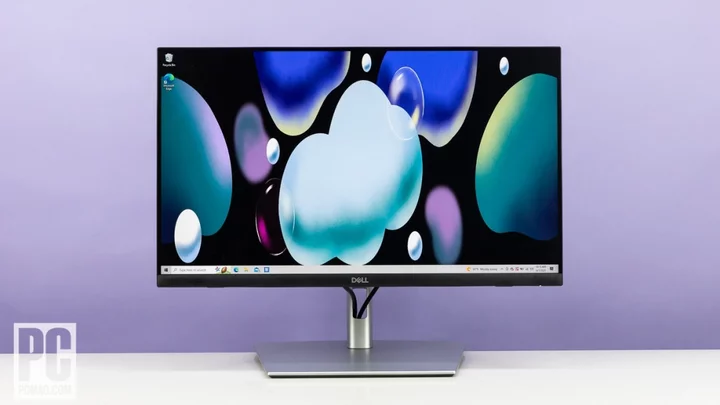The Dell 24 Touch USB-C Hub Monitor (P2424HT) feels like it's two monitors rolled into one. The P2424HT ($519.99) is a productivity monitor with a USB hub and all the ports you would expect from a laptop docking station. It has a responsive, gesture-based touch screen that is easy to manipulate with your fingers. Its stand is ergonomically flexible, so you can in effect switch it from a desktop monitor into a tablet-like mode. Its brightness, contrast, and color coverage are all we could have asked for. The P2424HT is expensive for a 24-inch monitor—though Dell currently sells it for a discount at $414.99, well below the MSRP—but it's quite decently priced when you factor in its connectivity, ergonomics, and uncommon touch functionality.
The Design: Multi-Touch Screen, Flexible Stand, Connectivity Galore
The Dell P2424HT has a 23.8-inch screen (measured diagonally) with a resolution of 1,920 by 1,080 pixels—also known as 1080p or full HD (FHD). The screen uses in-plane switching (IPS) technology. The panel's pixel density is 93 pixels per inch (ppi), which should produce a reasonably sharp image (assuming the original source signal and material is sharp), sufficient though less than ideal for tasks like basic art preparation or photo editing.
The P2424HT's screen is touch-sensitive, accepting the standard finger-based gestures, allowing you to tap, slide, swipe, and pinch. It supports 10-point touch (up to 10 fingers) with Windows and Macs, and three-point touch with Linux. The screen proved very responsive to my touch. Dell does not include a stylus, nor does it list one as a recommended accessory. Although a stylus is not as necessary as it would be for a smaller touch screen, one would have come in handy for tasks such as selecting closely spaced taskbar icons in programs like Photoshop.
As an IPS panel, the P2424HT's screen offers wide viewing angles, up to 178 degrees for both vertical and horizontal. This enables you to look at the screen nearly edge-on from the side or above without a notable degradation in image quality.
(Credit: Joseph Maldonado)Such awkward views may seldom be necessary, as the monitor's articulating stand offers an unusual degree of flexibility in screen positioning, particularly in its tilt range. When the P2424HT is fully upright in normal-monitor model, you can tilt the top of the screen up to five degrees toward you, and when it's in tablet mode (with the bottom edge of the chassis touching your work surface), the top of the screen is tilted up to 60 degrees away from you. The panel can be swiveled up to 30 degrees to either side, and its height can be adjusted up to 4.4 inches. The P2424HT doesn't support full pivot control, but Dell does include a so-called slant function: you can tilt the top of the screen up to 4 degrees from the horizontal, to either side.
(Credit: Joseph Maldonado)One of the P2424HT's strengths is its rich selection of ports. An upstream USB-C port provides both DisplayPort Over USB and up to 90 watts of USB power delivery (PD), letting you charge or power a laptop connected to it. You'll also find an HDMI port, a DisplayPort connector, a USB-C downstream port, three USB-A ports, and a headphone jack.
An RJ-45 Ethernet jack keeps you connected at the office or at home even in Wi-Fi dead spots. It also supports several network management functions: Preboot eXecution Environment (PXE) Boot, Wake-on LAN (WoL), and MAC address pass-through. PXE Boot allows a computer to boot directly from the network. WoL enables a computer to be roused remotely from a low-power state. And the MAC address pass-through function lets the laptop bypass the monitor/dock's MAC address so it can be uniquely identified on the network with its own address.
(Credit: Joseph Maldonado)Most of the connectors face downward in back, but two of the downstream ports—the USB-C port and one USB-A port—are located in a bay in back near the left side. These sideways-facing ports provide power delivery (up to 15 watts for the USB-C port, and up to 10 watts for the USB-A connector) for charging small devices.
(Credit: Joseph Maldonado)You navigate the P2424HT's onscreen display (OSD) by means of a mini-joystick controller, located just above the power button on the right side in back. The controller is responsive, and the menu system intuitive and easy to use.
(Credit: Joseph Maldonado)Dell backs the P2424HT with a three-year warranty, which is a typical length for productivity monitors.
Testing the Dell P2424HT: Solid Brightness, Contrast, and Color
I measured the P2424HT's brightness, contrast, and color coverage using a Klein K10-A colorimeter, a Murideo SIX-G signal generator, and Portrait Displays Calman software. The PH2424HT did well in all three areas. The monitor's tested luminance (brightness per unit area) exactly matched its rated luminance of 300 candelas per meter squared (nits). The contrast ratio came in at 1,399:1, considerably better than its 1,000:1 rating (which is standard for IPS panels).
(Credit: Portrait Displays)Dell rates the P2424HT's sRGB color coverage at 99%. It did even better in our testing, providing full (100%) sRGB coverage (see the chromaticity chart above). The sRGB color space is used for online art prep and numerous other applications.
I also viewed photos from our test suite as well as selected video clips on the P2424HT. Colors in the photos seemed realistic, with good contrast. Video was smooth, with rich and accurate-looking colors, and good retention of detail in both bright and dark scenes.
The P2424HT's built-in 3-watt speaker is typical of productivity monitor offerings, with modest volume and mediocre sound quality.
Verdict: A Desktop Monitor With the Right Touch
Although we have seen a number of portable monitors with touch screens in recent years, desktop touch-screen displays are a rarity. The last we reviewed was the ViewSonic TD2455, an Editors' Choice-award-winning model that has a 23.8-inch IPS screen with FHD resolution, and a similar articulating stand that can switch between desktop and tablet mode. It comes with one thing the P2424HT lacks: a stylus. It also has a second DisplayPort connector, letting you daisy-chain a second monitor into the setup.
That said, the P2424HT has a better overall selection of ports, including Ethernet and a second USB-C port. It has a mini-joystick controller, while the TD2455's menus are navigated by means of five small buttons on the bottom bezel. The P2424HT was brighter and showed much better contrast than the TD2455 in our trials, and it tested to 100% sRGB color coverage, while the ViewSonic's sRGB coverage was 94.6%.
(Credit: Joseph Maldonado)Be forewarned that you do pay a considerable premium for a touch-enabled display over a non-touch monitor of the same screen size and resolution. For a portable touch-screen monitor, consider the Editors' Choice-winning Asus ZenScreen Touch (MB16AMT) or, if money is no object, the Ricoh Portable Monitor 150BW with its beautiful OLED screen. But the best desktop-style touch-screen monitor we have come across, and our new Editors' Choice winner in that category, is the Dell 24 Touch USB-C Hub Monitor (P2424HT).









